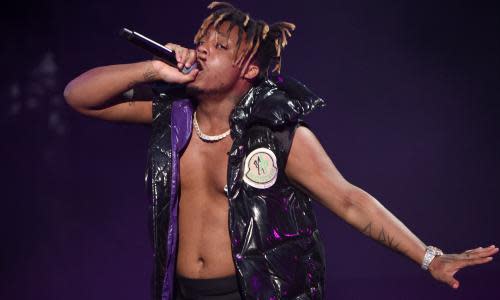Juice WRLD: Legends Never Die review – patron saint of the melancholy masses

Juice WRLD’s posthumous album opens with the devil closing in. On Conversations, the rapper is avoiding a tête-à-tête with the arch fiend himself, a manifestation of sin and lurking temptation. Across a four-song suite that sets the tone of Legends Never Die, imagery of demons and hell are persistent. Drugs are presented as a means to self-medicate and keep these terrors at bay, but they linger in the margins. Throughout the record, the Illinois rapper, who overdosed on oxycodone and codeine last December, is clearly searching for an escape. He never found what he was looking for.
The burden thus falls on this album, allegedly the first of many planned for release, to not only assess Juice’s vulnerable and enchantingly accessible music and chart a trajectory left unrealised, but also to dissuade his audience from following a similar path. Rapper Lil Bibby, head of Juice’s Grade A label and steward of his catalogue, said the album would be representative of “somebody that was fighting addiction, anxiety, detachment” and hoped those listeners who saw their struggles reflected in the songs might seek help. The album itself mines the topics for which Juice became known, namely emptiness and its many side-effects: substance abuse, destructive co-dependence, fear of self-sabotage, and, of course, fear of death, which looms around every corner. As with his previous album, 2019’s Death Race for Love, it is overstuffed, sometimes underwritten and often puerile, but there he was finding his voice. These songs open up beyond his internal monologue to reckon with his public –and by extension, his legacy.
As inspired by Fall Out Boy’s From Under the Cork Tree as Kanye West’s 808’s & Heartbreak, Juice WRLD’s songs rely on poignancy and self-loathing as a propulsive engine. Legends charts the emo middle ground between those two albums – in the catchy, mopey lovesickness (Come & Go) and in the overwhelming, depressive solitude and insecurity (Can’t Die). And he has never sounded more in tune with his smelting delivery than on Legends Never Die. Juice had distilled his singsong raps through emo pop in a way his most celebrated peers hadn’t, extracting a blend even purer than Post Malone’s; he was the most complete artist on his scene, far more refined than XXXtentacion and far less nostalgic than Lil Peep. He had a supernatural knack for melody and an aptitude for freestyling that allowed him to churn out songs by the thousands, the best of which found producers like Nick Mira and Rex Kudo transmuting elements of power pop and punk into vehicles for his rambler rap instincts. Having moved away from the bratty, jilted trap of his debut Goodbye & Good Riddance, songs like the irradiant Righteous and Up Up and Away look inward at bad habits forming.
Related: ‘I never got to thank him’: fans mourn a generation of rappers dying young
“The neurotic self-entanglement of the boy singer”, as untangled by the critic Jess Hopper in a 2003 treatise on emo called Where the Girls Aren’t, still plagues the world of Juice’s songs, and it can be difficult to reconcile his very real suffering with his tendency to weaponise it against lovers, or overlook the suffering he’s inflicted. He was not immune to emo’s toxicity. There’s a recurring theme in his music of threatening his girlfriend with violence at the sheer prospect of leaving him that continues here (Tell Me U Luv Me), and there’s rarely a moment that he thinks of her as much more than a cure for what ails him. But on this album, his relational myopia gives way to a secondary agenda: leading his listeners through their own angst. On Bad Energy and Fighting Demons, he sounds like a patron saint of the melancholy masses. Barely 21, Juice WRLD was only just coming into his own as a man and artist, his talent still taking shape as he matured. Legends Never Die reveals a glum ringleader still finding himself.

 Yahoo News
Yahoo News 